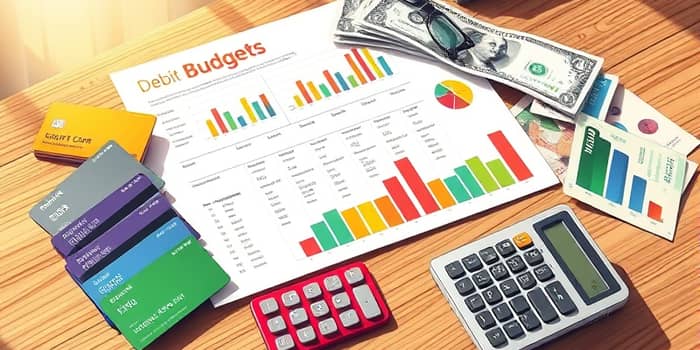In an age where plastic often replaces paper, mastering a card-driven budget can unlock greater control, deeper savings, and reduced debt. By harnessing credit and debit card features strategically, you can transform financial stress into clarity and progress.
Why Budget with Cards?
Cards provide an unprecedented level of visibility and convenience. With modern tools, you gain real-time spending insights and categorization, ensuring you never lose track of where your money goes. Credit cards offer built-in fraud and purchase protection, shielding you from unauthorized charges. Meanwhile, consistent on-time payments can build your credit history, opening doors for future loans at favorable rates.
- Easy expense tracking via statements or apps
- Potential rewards like cashback and points
- Enhanced security and purchase guarantees
- Opportunity to build a strong credit profile
Despite these advantages, there are inherent risks if cards are mismanaged. Carrying balances can lead to minimize high-interest debt risk becoming a daily struggle. The disconnect between seeing virtual numbers and tangible cash can fuel impulsive spending, especially when limits feel like limitless funds.
- High-interest rates on revolving balances
- Emotional distance leading to impulse purchases
- Over-reliance on credit limits as extra cash
Understanding Card-Driven Budgets
A structured card budget hinges on clear categorization and spending limits. Begin by analyzing past statements to identify patterns—rent, utilities, groceries, entertainment, and more. Historical trends, especially around holidays and seasons, can inform how you allocate funds month to month. This practice leverages historical seasonal spending patterns to prevent surprise overspending spikes.
Once categories are set, assign realistic caps to each. Separate essential "needs"—mortgage, bills, groceries—from discretionary "wants" like streaming services or dining out. For example, converting your dining budget into a weekly cap of $100 can halt runaway spending, mirroring the success of a client who cut entertainment overspending by 40% with clear digital envelopes.
Popular Budgeting Frameworks (with Cards)
- 50/30/20 Rule: Allocate 50% to needs, 30% to wants, 20% to savings and debt repayment. Adjust proportions if you carry balances, shifting more toward debt payoff.
- Envelope System Adaptation: Use debit cards or specialized app features to simulate physical envelopes, stopping spend when each digital envelope is empty.
- Seasonal Budget Planning: Review last year’s expenses for holidays, travel, or back-to-school costs, and build larger buffers during peak months.
Each framework provides a scaffold; the key is consistency. Identify which method aligns with your financial goals and experiment until you find a rhythm that sticks.
Card Payment Strategies
Automating payments is foundational. Set up automate minimum payments to prevent late fees and credit damage. Ideally, automate full balance payments every month to sidestep interest altogether. However, if you must carry a balance, choose a debt snowball or avalanche method:
The proven debt snowball method focuses on conquering the smallest balance first, creating quick psychological wins. Conversely, the avalanche strategy attacks the highest-interest debt, saving you the most in interest charges over time. Both approaches require disciplined payment plans—allocate at least 20% of your monthly income toward debt reduction for meaningful progress.
Tools and Technology
Today’s financial landscape is rich with apps and platforms designed to link seamlessly with your cards. Many banking apps offer integrated budgeting apps with alerts, breaking down spending by category and warning you when you approach limits. Third-party tools like Simplifi or YNAB provide advanced features, including customizable reports, projected balances, and goal-tracking dashboards.
Leverage these tools to consolidate data across accounts, track subscriptions, and forecast upcoming bills. The frictionless experience of auto-syncing transactions can be a game-changer—until it isn’t. If you notice impulse charges creeping up, consider adding manual steps, such as reviewing each transaction before approval.
Maximizing Card Perks and Features
Credit cards come with more than rewards; they offer negotiated perks, retention bonuses, and limit adjustments. Regularly review your credit agreements and request better terms when appropriate. If you hold multiple cards, designate one for everyday essentials to accumulate points faster, and another reserved for bonus-category spending.
Being strategic about signup bonuses, quarterly categories, and statement credits can yield significant annual savings. Always align your card usage with upcoming expenses—book travel through your preferred card during bonus periods, and pay utilities automatically to earn consistent rewards.
Combating Overspending and Debt
To fight impulsive buys, implement online purchase friction by removing saved cards from e-commerce sites. Switch high-risk discretionary categories—like dining out and entertainment—to debit or cash to add tactile awareness. Conduct a monthly audit of subscriptions, eliminating those you don’t use.
Supplement these cutbacks with additional income streams. Side hustles such as freelance writing, rideshare driving, or online marketplaces can fuel your debt repayments. Allocating side income exclusively to pay down credit balances accelerates progress without crimping your regular budget.
Key Numbers & Facts
Actionable Steps to Get Started
Follow these steps to implement a card-based budget today:
- Define clear financial objectives: emergency fund, zero credit balance, reward optimization.
- Link cards to a budgeting platform and categorize every transaction monthly.
- Automate both payments and savings transfers to enforce discipline.
- Choose a debt reduction method and allocate at least 20% of income.
- Trim non-essential expenses and introduce friction for impulse categories.
- Explore side income opportunities to supplement repayments.
By combining thoughtful planning with the right tools, you can transform your cards from potential liabilities into powerful allies in your financial journey.
monthly budget review habit and disciplined card management will set you on a path to greater security, reduced stress, and tangible progress toward your financial goals.
References
- https://www.kemba.org/resources/education/credit-card-budget
- https://www.texasbaycu.org/articles/budgeting-for-managing-credit-card-debt
- https://www.bairdwealth.com/insights/wealth-management-perspectives/2022/08/5-strategies-for-paying-off-credit-card-debt/
- https://www.cbsnews.com/news/effective-ways-to-curb-credit-card-spending-fall-2025-according-to-experts/
- https://www.quicken.com/blog/10-newyears-budgeting-tips/
- https://www.khcreditunion.com/use-these-7-credit-card-tips-to-stretch-your-budget-2025/
- https://www.bediasbank.com/post/mastering-your-finances-in-2025-practical-budgeting-tips-to-reach-your-financial-goals










